|
⇐ Previous Article — Table of Contents — Next Article ⇒
New Energy Times home page
Randall Observations of Steam Generated by Rossi's Device in the Ny Teknik Video
Appendix 10 to New Energy Times Report #3
(See related Appendix 35 and video)
By Mitch Randall
Ny Teknik Demonstration - Introduction
On April 28, 2011, Mats Lewan, a journalist for the Swedish energy technology magazine Ny Teknik, viewed a live demonstration of Andrea Rossi's device. Lewan recorded a video of this demonstration in a single take and posted it on YouTube[1]. The video starts with Rossi contemplating the data displayed on his laptop.
Lewan records the instrumented global input power, with the assumption that it is constant throughout the experiment.
However, the power can be increased or decreased on the fly by pressing the power controls on the front of the blue box. Because there is no other input power metering or logging in the system, the only power level known for certain is the power at the moment Lewan has his camera on the power meter.
He leads the viewer through various features of Rossi’s system. Near the end, Lewan follows the outlet hose to the next room and records the steam exiting into a blue plastic bucket. In the video, sometimes evidence of steam is visible and audible, and sometimes it is not.
The video clip finishes with Lewan returning to the room that houses the workbench for a brief discussion while Rossi is standing in front of the heater controls.
Did Rossi increase the power as Lewan approached the end of the hose and observed steam, and did Rossi reduce the power after Lewan walked away from the end of the hose?
To aid in answering this question, a supplemental report is provided, “Detailed Analysis of the Rossi Device,” describing the features and operation of the Rossi device based on available information.
As the analysis in the supplemental document makes clear, the only control Rossi could have of the device is to adjust power going into the heating resistors. The only information Rossi had on which to base a legitimate adjustment was three temperatures, which were essentially constant.
If Rossi made an adjustment to the power, he did not alert Lewan to this fact, as would have been appropriate. Further, Rossi appears not to have had enough information to make a legitimate power adjustment. The only remaining possibility is that his adjustment of power was not legitimate.
0:48 Lewan Records Input Power
At 0:39 in the video (Figure 1), Lewan shows the electrical input being measured using an ammeter. A few seconds later, at 0:48, the camera zooms in to show the meter clearly reading 1.6A. The line voltage[2] is 236V, so the input power is 378W. We assume that this input power remains constant during the demonstration so that the output power can be compared to a known input power. Because no log of applied power is given, a constant power level would be required in order to make a meaningful comparison of the input and output power.
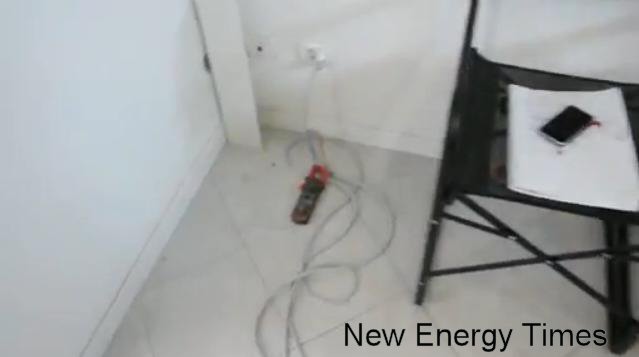
Figure 1
For the demonstration of April 28, 2011, the stated rate [2] of inlet water flow is 3.8 kg/h, or 1.1g/s. The input electrical power [2] is measured at 1.6A at 236VAC = 378W (assuming a power factor of one). Lewan believed that 65W was going to the devices inside the blue box. We do not have sufficient information to know whether the blue box contains any logic controllers or electronics in addition to the power adjusters. Therefore, the remaining power delivered to the heaters is assumed to be 313W.
The inlet water temperature was measured at 20C, and the boiling point at the Bologna altitude is 99.5C. Thus, the water temperature must raise 79.5C to begin boiling.
Because water has a heat capacity of 4.18 J/g.K, the inlet mass flow is 1.1g/s and the temperature rise required for boiling is 79.5C, the amount of power required to get to boiling is 4.18 J/g.K X 1.1 g/s X 79.5C = 365W.
This means that the 313W of electrical input power delivered to the heaters is not sufficient to create steam unless it is accompanied by an anomalous source of heating power.
Therefore, the presence of any steam exiting the hose under these parameters indicates that excess power is being produced by the device.
3:05 Lewan Turns to End of Hose
At 3:05 (Figure 2), Lewan turns toward the end of the hose that runs along the floor and goes into the adjacent room. Figure 2 shows the scene at 3:05 in the video. No sound is audible from the bucket and the end of the hose, which are out of sight just around the corner.
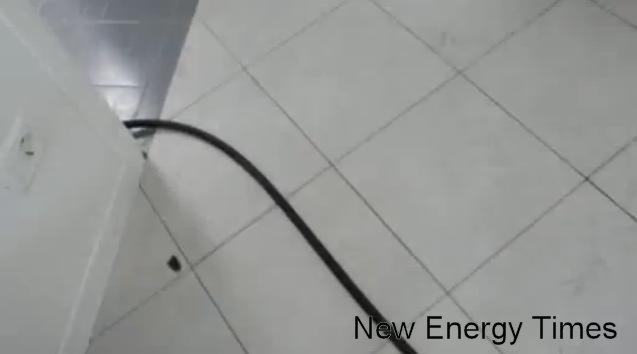
Figure 2
3:10 Lewan Approaches Bucket
At 3:10 (Figure 3), Lewan approaches a bucket in the adjacent room. The steam hose rests inside it. At this time, no gurgling or bubbling sound is audible from the steam or water entering the bucket from the hose. At this time, no bubbles are visible, but a very small amount of surface disturbance is visible. No steam is visible.
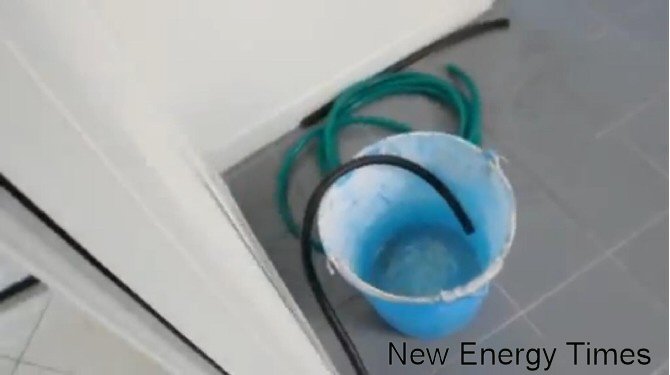
Figure 3
3:15 Closeup of Steam
At 3:15 (Figure 4), 5 seconds later, loud gurgling sounds are audible, and steam begins to be visible. By 3:26, copious steam is visible. Between the time of the last image and this image, the camera pans away from the end of the hose as the character of the sound changes abruptly. The way this occurs is consistent with the end of the hose, having been previously submerged, being pulled out of the water by Lewan.
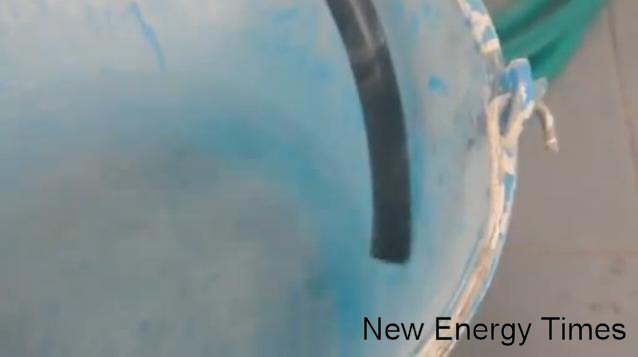
Figure 4
3:38 Lewan Places Hose Deeper Into Bucket
At 3:38 (Figure 5), Lewan places the hose deeper into the bucket. At this time, a copious amount of steam is coming out of the hose. A loud gurgling sound is audible. When the end of the hose appears to go below the surface of the water, bubbling is visible and audible. A great deal of turbulence is visible on the surface of the water.
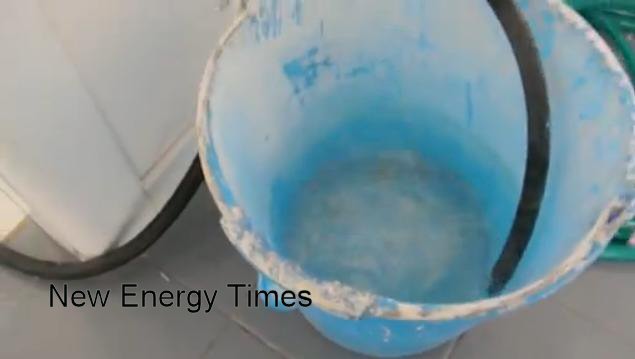
Figure 5
As Lewan stands up and gains distance from the bucket, the bubbling sound of the steam is clearly audible. At that point, the position of the camera is similar to the position of the camera in Figure 3, but the audio and visual evidence of steam is markedly different.
Lewan narrates, stating that the power “should be about 3kW.” He turns to his left, moves through the doorway, camera pointed toward the floor, and toward Rossi, who is standing behind the workbench.
The bubbling of the steam in the water is still audible, echoing in the room as Lewan approaches Rossi.
The bubbling sound remains audible even though Lewan is now farther away from the bucket than when he first approached the bucket. The bubbling is also audible even though the camera’s directional microphone is pointed away from the bucket. There was no noise from the bucket when Lewan approached it, not even as he moved down close to it.
3:47 Lewan Walks Into Room to Find Rossi With His Hand Near the Power Adjuster
At 3:47 (Figure 6), 9 seconds have passed since copious amounts of steam and bubbling were observed. 37 seconds have passed since we observed no evidence of steam.
Lewan raises the camera. Rossi appears to be adjusting something on the front of the blue box. At this time, the bubbles are barely audible, either because Lewan is too far away or because a change has occurred in the system performance.
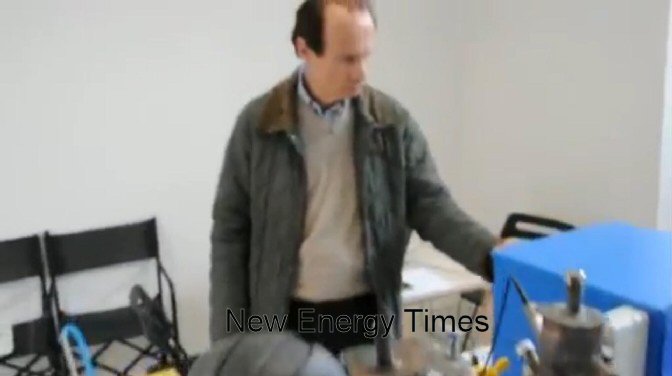
Figure 6
These observations raise an obvious question: Did Rossi increase the heater power as Lewan entered the adjacent room to observe steam, and when Lewan returned, did Rossi decrease the power to its previous level?
In a personal communication, I asked Lewan about this question:
Från: Mitch Randall
Skickat: den 8 juni 2011 03:49
Till: Lewan Mats
Ämne: Re: SV: Help with the blue module make and model
Mats,
Thanks Mats! Very helpful! I really appreciate you finding that for me and sending it!
I wasn't able to confirm until now, but these are just modules that adjust the power to the heaters. There are two heaters: a ring heater and a cartridge heater. Each module adjusts the power to each of the two heaters. That all seems to make sense.
That leads to a question: In your video, after observing the steam, you pan up and walk into the other room, where Rossi is adjusting something. As far as anyone can tell, there is nothing adjustable except heater power.
Did he and you talk about the fact that he would be adjusting the power while you are filming?
Since I recently noticed this, I looked at the video again and noticed that, when you initially walk up to the bucket, it has very mild activity. I can't see or hear the bubbles. By the time you stick the hose back in the bucket, it is noticeably more active - the bubbles are clearly visible and can be heard distinctly.
Help me out here: Did Rossi turn up the power while your attention was drawn to the bucket? Then, was he turning it back down when you walked back in the room? What do you think?
Best regards,
Mitch |
Lewan replied:
From: Lewan Mats
To: Mitch Randall
Sent: Wednesday, June 8, 2011, 2:10 a.m.
Subject: SV: SV: Help with the blue module make and model
Mitch,
This is a thing many persons have noticed in the video and asked me about.
The easy answer is that I checked the steam flow continuously during the test, not only during the video take, and the behavior was very similar all the time. It seemed calm down under water and increased when the tube reached the surface.
The steam flow actually appeared weak also to me, fluctuating depending on how deep down the tube was immersed in the condensed water in the bucket.
Now, I have found out that steam flowing along a tube of 3 meters, condensing, and then flowing out under water which is not 100 degrees does not behave in an intuitive way. It’s not air. It’s vaporized water flowing into water. You should compare it to cold air flowing into liquid air.
Later, I remade similar experiments with water boilers at the same power (2.2 kW) and a tube of 3 meters, and it actually behaves in a very similar way.
As for what Rossi might have done – even if he momentarily would have increased the power of the electrical heaters, it wouldn’t have had that immediate effect.
As the steam question is crucial, I have discussed the steam/vapor physics with lots of people, lately a professor in this area at the Royal Institute of Technology in Stockholm (from where I have a master’s of science in engineering physics). Many [people] are concerned about the dryness of the steam and the calculations for phase change, but I believe we’re safe now.
Hope this helps.
Mats
|
As we see, Lewan does not know whether Rossi adjusted power during the experiment. If Rossi made an adjustment, he didn't tell Lewan about it.
Let's review the video. At first, the steam bubbling in the bucket is neither audible nor visible. As Lewan approaches the bucket, the steam appears to increase from virtually nothing to copious amounts in 16 seconds. As Lewan walks away from the bucket and back to Rossi in the adjacent room, the sound of bubbling steam is audible.
The camera films Rossi touching something on the front panel of the blue box. Did Rossi increase the heater power as Lewan entered the adjacent room to observe steam, and when Lewan returned, did Rossi drop the power back down to the level which Lewan had originally observed?
Control of Device
Figure 7 shows the block diagram of the Rossi device as in the supplemental report “Detailed Analysis of the Rossi Device.”[3] For the purpose of this discussion, the diagram does not provide for any form of closed-loop control of the Rossi device. Any control of the system must occur by direct operator intervention.
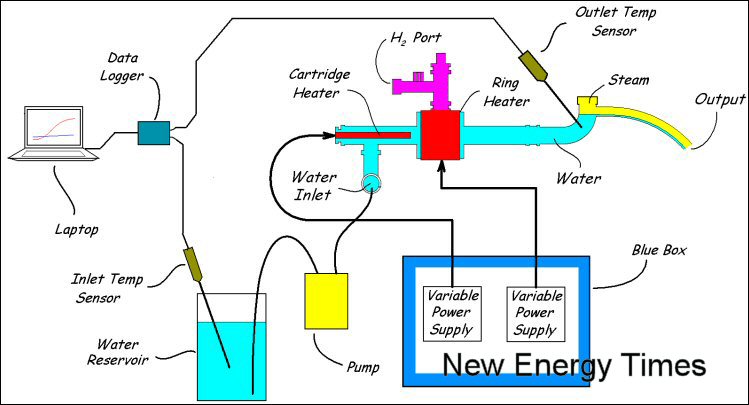 Figure 7 Figure 7
Because the laptop computer receives sensor signals but cannot physically send commands back to the device, the laptop computer cannot control the operation of the Rossi device. The laptop computer is used only for monitoring three temperatures. Figure 8 shows the display Rossi uses to determine the operation of his device[4].
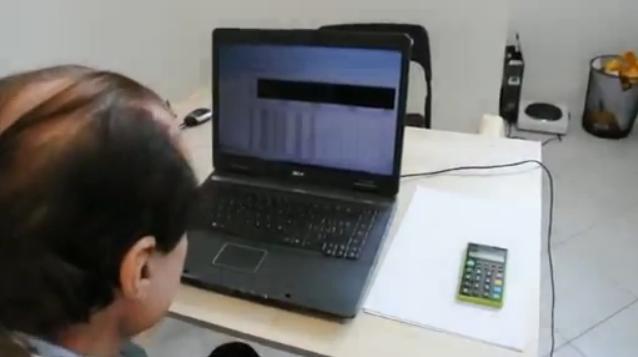
Figure 8
In the figure, Rossi looks at a display of three temperatures[5] in table and graphical form. The three temperatures are:
- Inlet Water Temperature: the temperature of a container of water sitting on the floor.
- Ambient Temperature: the temperature of the air provided by a sensor in the logger.
- Outlet Temperature: the temperature of a point internal to the Rossi device (presumably boiling water).
Also, because the blue box sends power to the device but has no physical means of sensing any of the device parameters, it, too, cannot control the operation of the device. The electrical connections from the blue box are the only connections to the device. The only controls that could reasonably be adjusted in real time by an operator are the power adjusters on the front panel of the blue box. These are shown in Figure 9 [6].
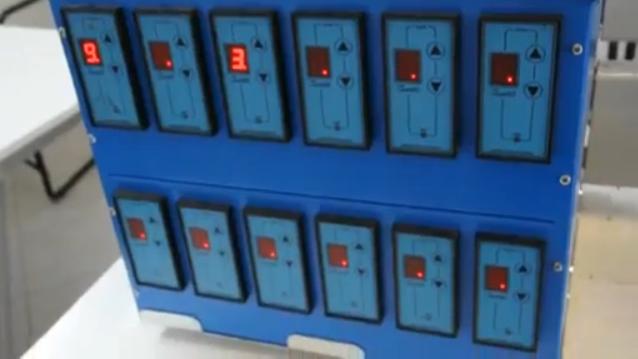
Figure 9
Thus, the only way in which the Rossi device can be actively controlled is by an operator making manual power adjustments to the heater through the front panel based on the three temperature readings as displayed on the laptop.
Interpretation
In the screenshot of Figure 6, Rossi appears to be adjusting the heater power. At the same time, the echoing sound of steam bubbling in the bucket in the adjacent room fades.
In Figure 9 from 1:04 in the video, one power adjuster is already at maximum, and the other power adjuster is at one-third of full power. 1:04 is near the time of the input power measurement in the Ny Teknik video. The third power adjuster appears to be positioned close to where Rossi seems to be touching, as shown in Figure 6.
Cartridge heaters have low thermal mass because they are designed to be part of a temperature control loop. Because of this and because the water is already at 100C, Rossi’s adjustment of power could cause an immediate change in output steam generation.
The input power and an accurate measure of it are important to evaluators of the Rossi device. Anyone involved in such an evaluation, particularly Rossi, should be aware that, once the input power is measured, it should not be changed before the output power has been measured.
At 3:47 in the video (the time of Figure 6), Rossi may have chosen to hold his finger on the blue box to balance himself or possibly to clean some grime from the instruments. However, if so, he chose a particularly poor time to do so. In addition, the video shows that his actions are consistent with someone pressing the power control buttons and watching and waiting for the power display to increment or decrement to a new value. Further, he apparently changed power more than one or two stops because his interaction with the controller lasts for a few seconds. Otherwise, it would have been just a quick press of a button. Still further, the sound of steam bubbling in a bucket in the adjacent room fades at about the time of Rossi’s adjustment.
If, indeed, Rossi adjusted the power, as it appears he did, then one of two situations exists:
- For some reason, Rossi adjusted power to control the device legitimately.
- For some reason, Rossi adjusted power to control the device illegitimately.
If Rossi legitimately adjusted power as in Case 1, he should have told Lewan that he did so and by how much. If it was significant, then the input power should have been measured again. If it was not significant, then Lewan should have been allowed to make that decision. Either way, a change in power should be described in Lewan's report or video commentary. It is not.
Because the only parameter of the device that Rossi measures is the fixed outlet temperature (always about 100C unless the water stops boiling), a sound argument can be made that Rossi could not have been controlling the device legitimately, as in Case 1 above. This reasoning leaves the alternate scenario of an illegitimate adjustment as the only remaining possibility. The fact that the steam flow seems to change significantly during the time Rossi had the opportunity to change the power further supports this conclusion.
References
1. Ny Teknik video, April 28, 2011, http://www.youtube.com/watch?v=x8SeOteFPtM.
2.
Ny Teknik , “Test of Energy Catalyzer,” Bologna, April 28, 2011, http://www.nyteknik.se/incoming/article3166569.ece/BINARY/Report+test+of+E-cat+28+April+2011.pdf.
3. Randall, M., “Detailed Analysis of the Rossi Device.”
4.
Ny Teknik video, April 28, 2011, 0:30, http://www.youtube.com/watch?v=x8SeOteFPtM.
5.
Levi, G., “Report on Heat Production During Preliminary Tests on the Rossi ‘Ni-H’ Reactor,” http://www.nyteknik.se/incoming/article3076881.ece/BINARY/Levis+and+Bianchinis+rapport+(pdf).
6.
Ny Teknik video, April 28, 2011, 1:04, http://www.youtube.com/watch?v=x8SeOteFPtM.
Brief Biography of Mitch Randall:
Mitch Randall is the chief technology officer and founder of Pure Energy Solutions Inc. Randall holds a master's degree in physics and a master's degree in electrical engineering and has 25 years of experience in high technology. He has been issued 12 patents and has two dozen pending. Randall has been interested in LENR for many years and recently began to snoop around at Coolescense, LLC, to continue to learn as much as he can about the field.
⇐ Previous Article — Table of Contents — Next Article ⇒ | 
